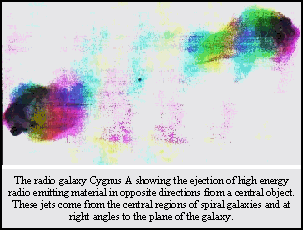|
|
|
|
Is an Alternative to the Big Bang a Possibilty?
The answer to that is yes. Despite the almost fanatical adherence of the science establishment to the validity of the Big Bang concept, there are dissenters. However human nature is such that they find it exceedingly difficult to have their work accepted for publication. As with most human activities, behind the science scene there stands reputation and power, as well as money. And money means politics which means power concentration with the few. Buck them and you will suffer.
Curiously, for the principal difference between the Big Bang and its major alternatives there is one small but vital difference. How long does it take for matter particles emerging from relatively undifferentiated energy to gain mass. The Big Bang has it all happen at the very first moments of time. That imposes on the subsequent theory a fifteen billion year interval to get us to "now."
One competing theory, the Quasi-Steady State Cosmology (QSSC) belongs mainly to the Brits--the Burbidge husband and wife team, the recalcitrant Fred Hoyle, and Empire survivor, the brilliant Indian Jayant Narlikar. A modification of QSSC stems from another rebel, Halton Arp, who disputes that the red shift of light from distant stars means higher recessional velocity and increased distance from us.
The primary difference between Hoyle et al., and Arp concerns the birth of matter. Hoyle and co-workers have it emerging from the vacuum with all of its mass but Arp allows time for the mass of a particle to grow and accumulate.
This difference between the three in regard to the time taken to gain mass has some spectacular consequences. And it appears that all groups are relying on an undiscovered Higgs boson to bring mass to their matter particles. The difference is how and when.
The Big Bangers are stuck with the Higgs giving them mass at the very beginning of the creation. They have nowhere to move from there. Hoyle et al., have matter emerging continuously from the vacuum and presumably the Higgs boson does its job at the moment of emergence. But Arp is unique. He has the mass of each particle grow over an extended period of time.
The great advantage of Arp's idea is that matter gets born with zero mass. Initially it can travel at the speed of light. This makes sense for problems associated with what we call quasars.
These appear to owe their birth to something funny going on at the heart of many galaxies. There, a conjectured Black Hole spews out enormously high temperature, high energy, and high speed superfluid-like jets at right angles to the plane of the mother galaxy.
Eventually these jets appear to give birth to new companion galaxies. But neither the Big Bang, nor Hoyle et al's QSSC, have an explanation for how particulate matter associated with such high speed, high temperature and high energy jets can exist if their matter particles have their full complement of mass. It is here that Arp's newly born zero mass particles come into their own. They can travel at the speed of light without having to be pumped up with an infinite relativistic mass having an impossible requirement for finding the energy to do so.
Arp's scheme has another advantage. It can explain the anomalously high red shifts associated with proto- and companion galactic materials that are measured for bodies associated with the jets from the mother galaxy. This despite the fact that they are at almost the same distance from us as their mother galaxy, which may have a red shift considerably lower than her apparent offspring.
Arp's scheme claims that new born zero mass atomic electrons, for example, would require much less energy to promote them to higher energy levels. So the photons they later emit when they fall back to their initial state will also have less energy, and therefore a longer wave length. Thus their photons will display a red shift when compared with electrons from the same kind of atom performing in the same way but having their matured level of mass.
|
|
|
|
|
|
|





